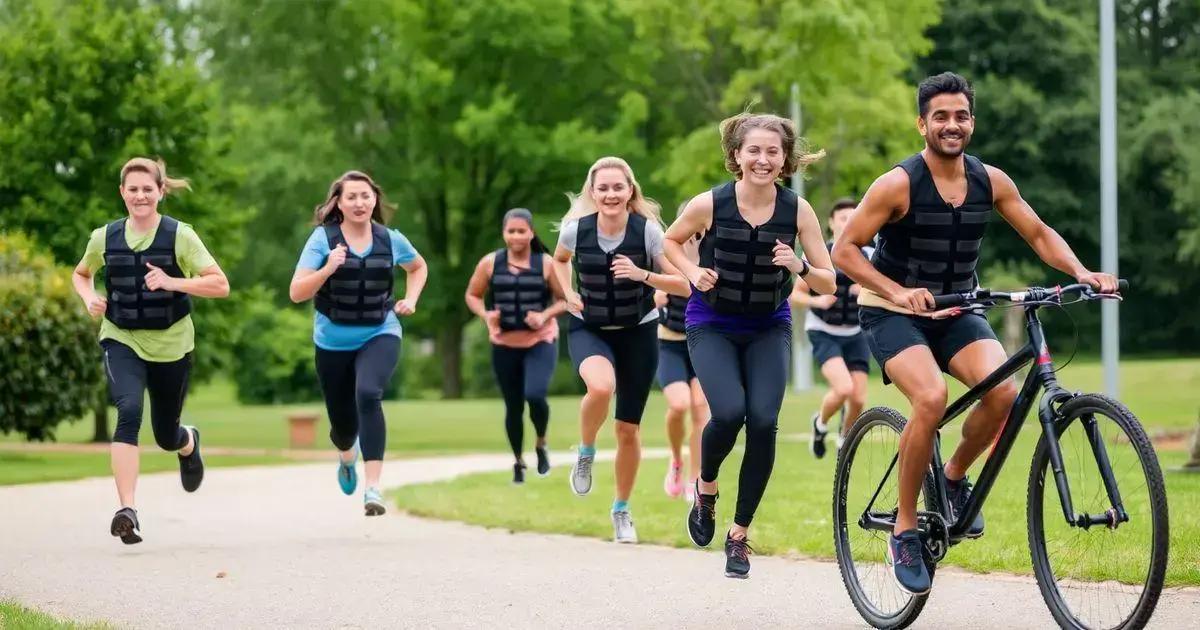Learn how to use weighted vests safely in cardio workouts by starting with lighter weights, maintaining good form, and choosing suitable exercises like walking, running, and bodyweight workouts. Avoid common mistakes such as using too much weight and neglecting hydration to maximize benefits and prevent injuries.
Weighted vests are an excellent tool for enhancing cardio workouts, offering an added challenge that can lead to greater fitness gains. However, how to use weighted vests safely in cardio workouts is essential to avoid injury. In this guide, we will discuss the benefits of using weighted vests, safety tips to ensure you train effectively, and the types of cardio workouts that can be performed safely with these weights. Moreover, we will highlight common mistakes to avoid for optimal performance.
Benefits of Using Weighted Vests

Using weighted vests in your cardio workouts can significantly enhance your training routine. When you add extra weight to your body, it challenges your muscles in a new way, leading to improved strength and endurance.
Improved Caloric Burn
One of the primary benefits of using weighted vests is the increased number of calories you burn during exercise. The additional weight forces your body to work harder, which can lead to greater fat loss over time.
Strengthens Muscles
Wearing a weighted vest not only boosts your cardiovascular fitness but also builds muscle strength. The added weight engages your core, legs, and upper body, helping to tone muscles effectively.
Enhanced Cardiovascular Endurance
Training with a weighted vest can increase your heart rate more than standard workouts. This means your cardiovascular system becomes more efficient, providing long-term health benefits.
Versatility in Workouts
Weighted vests offer versatility, allowing you to incorporate them into various cardio workouts like running, walking, cycling, and jumping rope. This adaptability makes it easy to challenge your body consistently.
Improved Posture and Stability
Using a weighted vest encourages upright posture. The extra weight helps to strengthen muscles that support your spine, promoting better overall stability and alignment.
Safety Tips for Wearing Weighted Vests

When incorporating weighted vests into your cardio workouts, following safety tips is crucial to prevent injury. Here are some key recommendations to help you train safely and effectively.
Start with Lighter Weights
Begin by using a lighter weighted vest to allow your body to adjust. As you build strength and comfort, gradually increase the weight to avoid strain.
Check Your Form
Maintaining good form is essential while wearing a weighted vest. Poor posture can lead to injuries, especially to your back and joints. Focus on keeping a straight back and proper alignment.
Listen to Your Body
Pay attention to how your body feels while working out. If you experience pain or discomfort, remove the vest, and pause your workout. It’s important to distinguish between effort and pain.
Stay Hydrated
Wearing a weighted vest can make you sweat more. Ensure you stay hydrated by drinking plenty of water before, during, and after your workouts to maintain optimal performance.
Opt for Appropriate Workouts
Choose cardio exercises that match your fitness level and experience with weighted vests. Start with low-impact activities like walking or cycling and gradually work up to higher intensity workouts.
Types of Cardio Workouts Suitable for Weighted Vests

Weighted vests can be used in various cardio workouts to enhance intensity and effectiveness. Here are some types of cardio workouts that are suitable for incorporating weighted vests.
Walking and Hiking
Using a weighted vest during walking or hiking is a great way to increase calorie burn without impacting joints. It challenges your cardiovascular system while improving endurance.
Running and Jogging
Adding a weighted vest to your running routine allows you to enhance your pace and build strength. However, be cautious with the weight to maintain form and prevent injury.
Cycling
Using a weighted vest while cycling can effectively increase the difficulty of your ride. It engages more muscles and boosts cardiovascular endurance as you pedal.
Jumping Rope
For a great full-body workout, try jumping rope while wearing a weighted vest. This exercise elevates your heart rate and encourages better coordination and agility.
Bodyweight Exercises
Incorporate a weighted vest into your bodyweight exercises like push-ups, squats, and lunges. The additional weight can help build strength and enhance the effectiveness of these workouts.
Common Mistakes to Avoid with Weighted Vests

When using weighted vests during exercise, avoiding common mistakes is essential for safety and effectiveness. Here are key pitfalls to watch out for.
Wearing Too Much Weight
One of the biggest mistakes is using a vest that is too heavy. Start with a lighter weight and gradually increase it as your body becomes accustomed to the extra challenge.
Poor Posture
Another mistake is neglecting your form. Focus on maintaining proper posture during workouts. Hunching over or leaning too far can lead to injury.
Neglecting Warm-Up
Failing to warm up properly before wearing a weighted vest is a common error. Warming up helps prepare your muscles and joints, reducing the risk of injury.
Skipping Hydration
Some people forget to stay hydrated while exercising with a weighted vest. Increased weight can make you sweat more, so drink water before, during, and after your workout.
Using Vests for All Exercises
Not all exercises are suitable for weighted vests. Be mindful of which workouts you use the vest with. High-impact activities may increase injury risk if performed improperly.
In Summary: Safely Use Weighted Vests for Effective Workouts
Weighted vests can significantly enhance your cardio workouts by improving strength, endurance, and calorie burn. However, it is crucial to implement them safely to avoid injury. Start with lighter weights, maintain proper form, and stay hydrated throughout your sessions.
Incorporating options like walking, running, and bodyweight exercises can make your workouts more versatile and engaging. Be mindful of common mistakes, such as using too much weight or neglecting warm-ups, to maximize the benefits of your training.
With these tips and techniques, you’ll be well on your way to effectively using weighted vests in your fitness routine, achieving better results while safeguarding your health.
FAQ – Common Questions About Using Weighted Vests in Cardio Workouts
What are the benefits of using weighted vests in workouts?
Weighted vests can enhance strength, improve endurance, and increase calorie burn during cardio exercises.
How do I choose the right weight for my vest?
Start with a lighter weight that allows you to maintain good form, then gradually increase the weight as you get stronger.
Are there specific workouts that are better for weighted vests?
Yes, exercises like walking, running, cycling, and bodyweight workouts are suitable for using weighted vests.
What safety tips should I follow when using a weighted vest?
Ensure proper posture, listen to your body, stay hydrated, and warm up before your workout.
What common mistakes should I avoid while wearing a weighted vest?
Avoid using too much weight, neglecting warm-ups, skipping hydration, and using the vest for improper exercises.
Can beginners use weighted vests safely?
Yes, beginners can use weighted vests if they start with light weights and follow safety guidelines to avoid injury.












